Why are the trig functions called sine, cosine and tangent?
Categories: gcse trigonometry
Level:

You probably know of the three main trigonometry functions - sine, cosine and tangent. You might also know of some extra trig functions called secant, cosecant and cotangent. And you might have seen that the inverse trig functions are sometimes referred to as arcsine, arccosine, etc.
But where do these names come from?
In this article, we will look at the origins of these names.
If you are not familiar with chords, tangents, and secants of a circle, take a look at the parts of a circle article.
Primary trig functions - sine, tangent, secant
When we think about the main trig functions, we usually think of sine, cosine and tangent. Those are the functions that are most often used to solve trigonometry problems.
But historically the sine, tangent and secant functions were considered the primary functions.
Why is this? If we form a triangle inside a unit circle, with an angle a at the centre, then the sine, tangent and secant functions will tell us the lengths of each of the three sides in terms of a. Each function is named after the side it relates to.
Sine function
The sine function is related to the chord of a circle. A chord is a line between two points on the circumference of the circle. Here is an example of a chord of a circle:
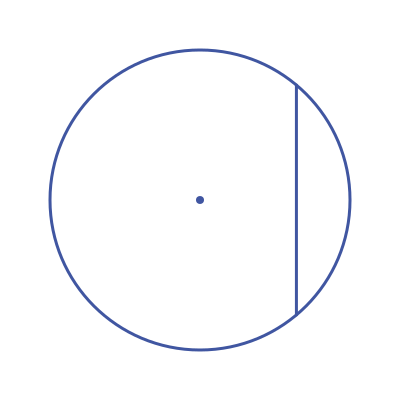
The word sine is an old term for the chord of a circle. It originates from the Sanskrit word for the string of a bow (as in a bow and arrow) because the chord and arc of a circle looks quite like a bow:

To understand how the sine function relates to a chord of a circle, we can draw a triangle within a unit circle:
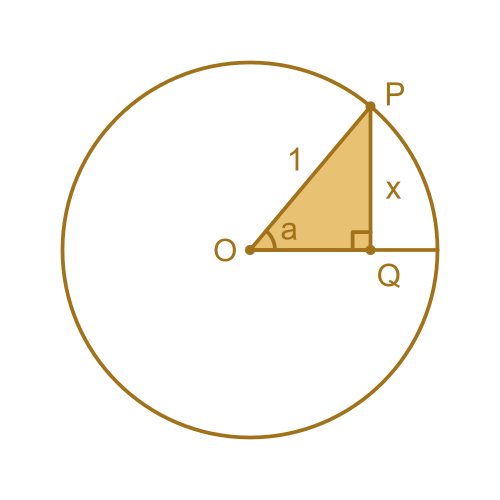
Here, the right-angled triangle POQ has an angle a at the centre. The hypotenuse, OP, has length 1 because it is a radius of the unit circle. The side opposite to angle a has length x.
The definition of the sine function is:

Substituting the values for opposite and hypotenuse gives:

Now if we draw a second, congruent triangle ROQ, we can see that the line PR forms a chord of the circle:
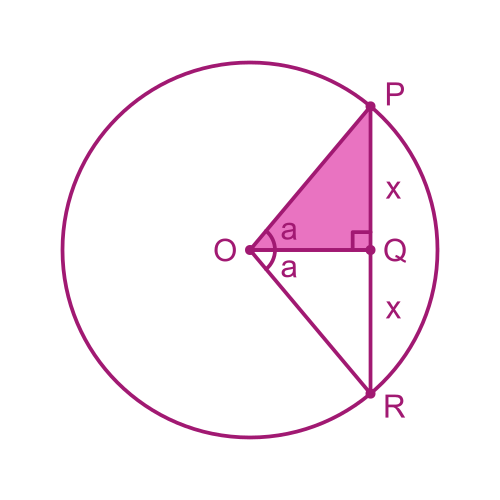
So sin a tells us the length x, which is the length of the side of the triangle that makes up part of the chord PR. We call it the sine function because sine means chord.
In fact, the length x is equal to half the length of the chord. The sine function was sometimes called the half-chord function, although that term is rarely used these days.
Tangent function
As you might expect, the tangent function relates to the tangent of a circle. A tangent to a circle is a line that touches the circumference of a circle, without crossing it. Here is an example:

Once again we can draw a triangle in the unit circle to discover how the tangent function relates to the tangent of a circle:
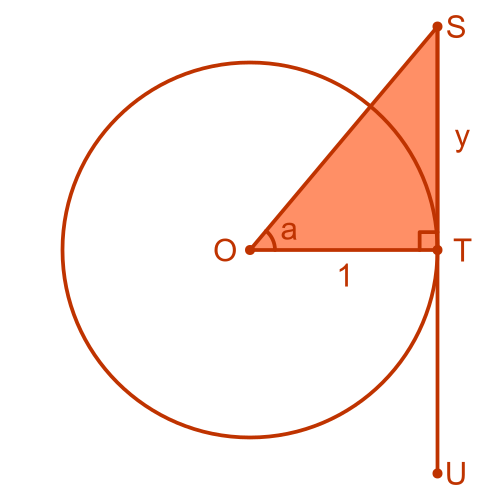
This triangle TOS is not quite the same as the one we drew for the sine function. The previous triangle had a hypotenuse of length 1, this triangle has the side adjacent to angle a of length 1.
The opposite side ST has length y.
The diagram also shows a tangent to the circle, the line SU. ST is part of that tangent line.
The definition of the tangent function is:
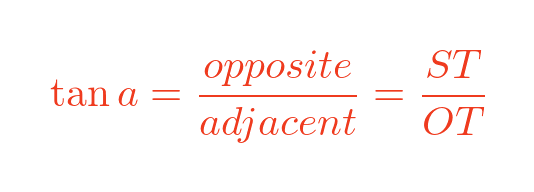
Substituting the values for opposite and adjacent gives:
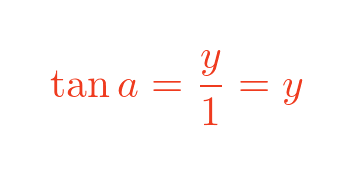
So tan a tells us the length y. This is the length of the side of the triangle ST that makes up part of the tangent SU.
We call it the tangent function because of this.
Secant function
The secant function relates to the secant of a circle, again as you would expect. A secant is a line that crosses the circumference of a circle in two places. A secant is similar to a chord, except that it extends outside the circumference:
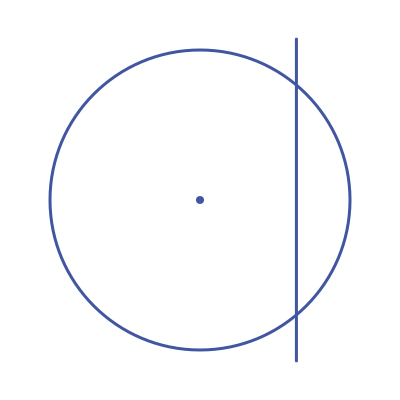
This time we draw the same triangle TOS that we drew for the tangent example:
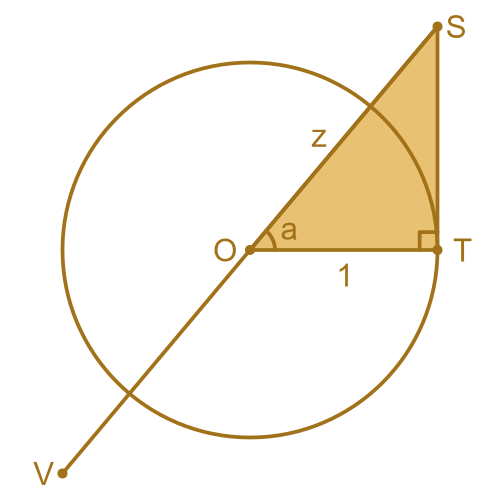
In this diagram the hypotenuse SO has length z. The adjacent side OT has length 1 because it is a radius of the unit circle.
The line SV is a secant to the circle, so the hypotenuse SO is part of the secant.
The secant function is the reciprocal of the cosine function, so it is defined as:

Substituting the values for hypotenuse and adjacent gives:

So sec a tells us the length SO, which is the length of the side of the triangle that makes up part of the secant SV. So we call it the secant function.
Secondary trig functions - cosine, cotangent, cosecant
The names of the secondary trig functions are formed by adding the prefix co to the name of one of the primary functions. This indicates that the function is based on the complementary angle.
In a right-angled triangle, the two acute angles a and b are called complementary angles:
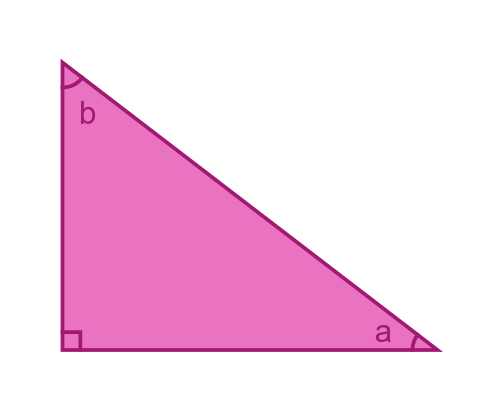
Angles a and b always add up to 90 degrees.
In the case of trig functions, the primary functions are based on the angle at the centre of the circle (that we have been calling a). The secondary functions are based on the complementary angle b.
Cosine function
This is the diagram we used before to illustrate the sine function, but this time the complementary angles b is shown too:
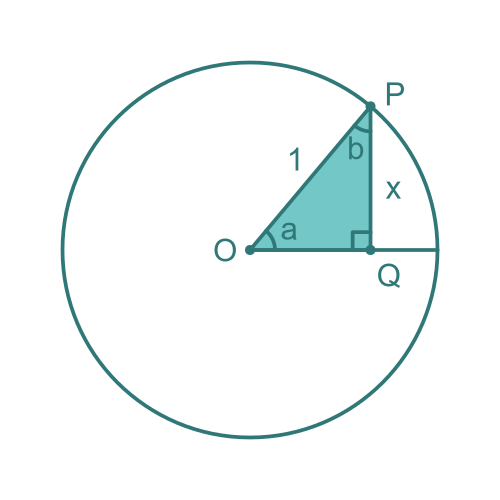
We have previously seen the equation for the sine function:

The cosine function applies to the same sides PQ and OP, but this time it relates them to angle b:
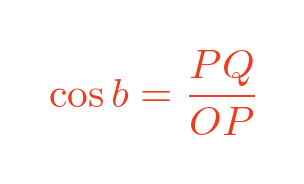
To be clear, the value of sin a tells us the length PQ (ie x)in terms of the angle a. The value of cos b also tells us the value of x, but in terms of the angle b.
Of course, side PQ is opposite angle a, but it is adjacent to angle b, so substituting the side names gives us the usual formula for cosine:

Cotangent and cosecant functions
The cotangent function can be found in a similar way. We won't go through it in detail, but the formula for angle cot b uses the same sides as tan a but switches opposite and adjacent:

Similar for the cosecant:

Inverse trig functions
The inverse trig functions allow us to find the angle from two sides, for example, if:

Then:

This inverse sine function is sometimes called arcsine of arcsin. Similarly, the inverse tangent can be called arctangent or arctan and so on.
Why is this? Well, if we measure an angle in radians, at the centre of a unit circle, then the length of the arc it creates is equal to the angle. Here is an illustration for arcsin:
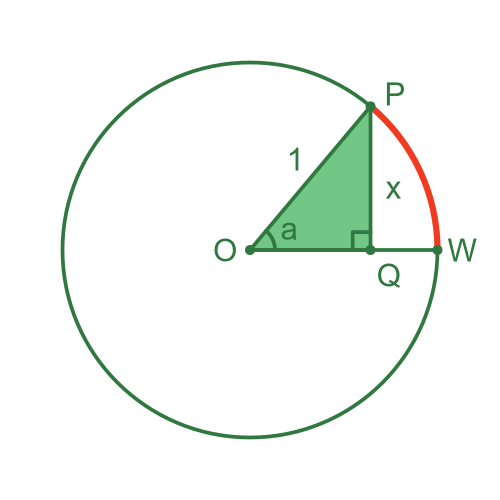
The inverse sine of x is equal to the length of the arc PW. It is also equal to the angle a too, of course.
Related articles
Join the GraphicMaths Newsletter
Sign up using this form to receive an email when new content is added to the graphpicmaths or pythoninformer websites:

Popular tags
adder adjacency matrix alu and gate angle answers area argand diagram binary maths cardioid cartesian equation chain rule chord circle cofactor combinations complex modulus complex numbers complex polygon complex power complex root cosh cosine cosine rule countable cpu cube decagon demorgans law derivative determinant diagonal directrix dodecagon e eigenvalue eigenvector ellipse equilateral triangle erf function euclid euler eulers formula eulers identity exercises exponent exponential exterior angle first principles flip-flop focus gabriels horn galileo gamma function gaussian distribution gradient graph hendecagon heptagon heron hexagon hilbert horizontal hyperbola hyperbolic function hyperbolic functions infinity integration integration by parts integration by substitution interior angle inverse function inverse hyperbolic function inverse matrix irrational irrational number irregular polygon isomorphic graph isosceles trapezium isosceles triangle kite koch curve l system lhopitals rule limit line integral locus logarithm maclaurin series major axis matrix matrix algebra mean minor axis n choose r nand gate net newton raphson method nonagon nor gate normal normal distribution not gate octagon or gate parabola parallelogram parametric equation pentagon perimeter permutation matrix permutations pi pi function polar coordinates polynomial power probability probability distribution product rule proof pythagoras proof quadrilateral questions quotient rule radians radius rectangle regular polygon rhombus root sech segment set set-reset flip-flop simpsons rule sine sine rule sinh slope sloping lines solving equations solving triangles square square root squeeze theorem standard curves standard deviation star polygon statistics straight line graphs surface of revolution symmetry tangent tanh transformation transformations translation trapezium triangle turtle graphics uncountable variance vertical volume volume of revolution xnor gate xor gate
